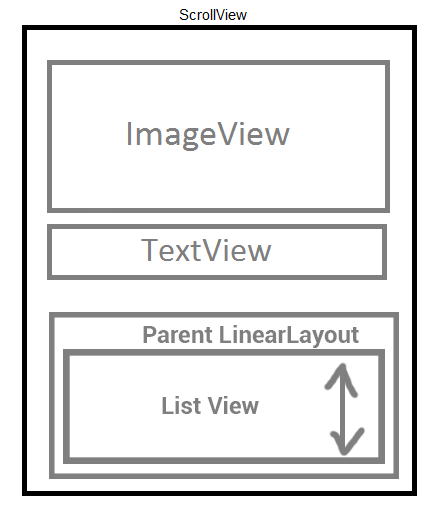You Create Custom ListView Which is non Scrollable
public class NonScrollListView extends ListView {
public NonScrollListView(Context context) {
super(context);
}
public NonScrollListView(Context context, AttributeSet attrs) {
super(context, attrs);
}
public NonScrollListView(Context context, AttributeSet attrs, int defStyle) {
super(context, attrs, defStyle);
}
@Override
public void onMeasure(int widthMeasureSpec, int heightMeasureSpec) {
int heightMeasureSpec_custom = MeasureSpec.makeMeasureSpec(
Integer.MAX_VALUE >> 2, MeasureSpec.AT_MOST);
super.onMeasure(widthMeasureSpec, heightMeasureSpec_custom);
ViewGroup.LayoutParams params = getLayoutParams();
params.height = getMeasuredHeight();
}
}
In Your Layout Resources File
<?xml version="1.0" encoding="utf-8"?>
<ScrollView xmlns:android="http://schemas.android.com/apk/res/android"
android:layout_width="match_parent"
android:layout_height="match_parent"
android:fadingEdgeLength="0dp"
android:fillViewport="true"
android:overScrollMode="never"
android:scrollbars="none" >
<RelativeLayout
android:layout_width="match_parent"
android:layout_height="wrap_content" >
<!-- com.Example Changed with your Package name -->
<com.Example.NonScrollListView
android:id="@+id/lv_nonscroll_list"
android:layout_width="match_parent"
android:layout_height="wrap_content" >
</com.Example.NonScrollListView>
<RelativeLayout
android:layout_width="match_parent"
android:layout_height="wrap_content"
android:layout_below="@+id/lv_nonscroll_list" >
<!-- Your another layout in scroll view -->
</RelativeLayout>
</RelativeLayout>
</ScrollView>
In Java File
Create a object of your customListview instead of ListView
like :
NonScrollListView non_scroll_list = (NonScrollListView) findViewById(R.id.lv_nonscroll_list);



(ListView)should still work fine. – Spikelet